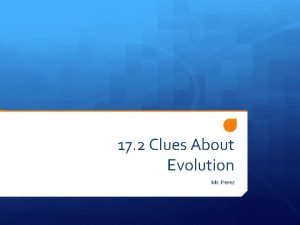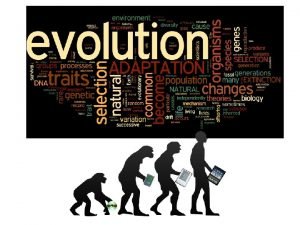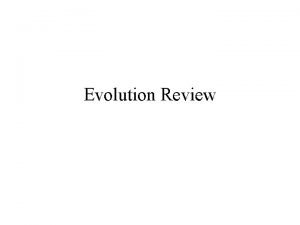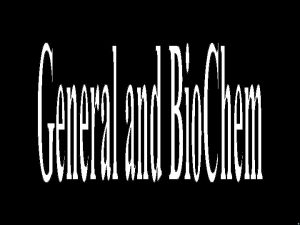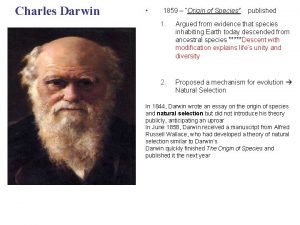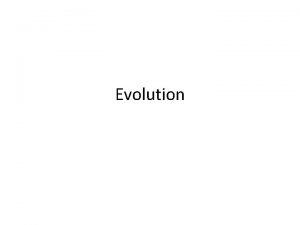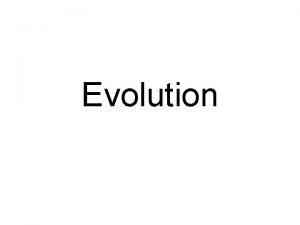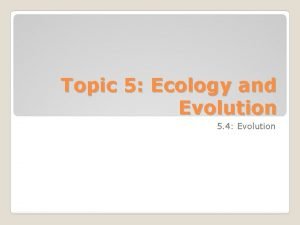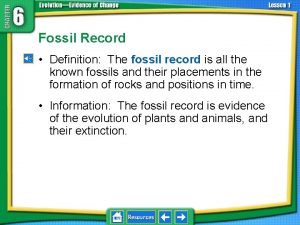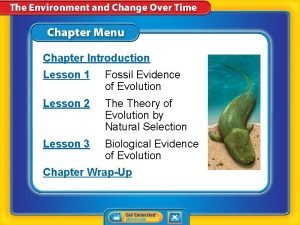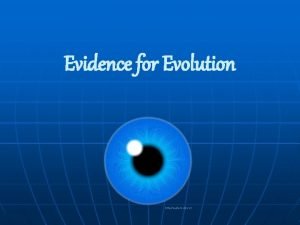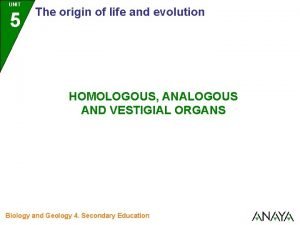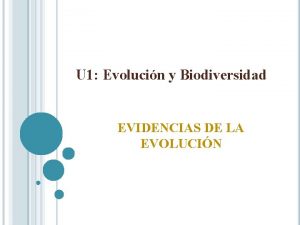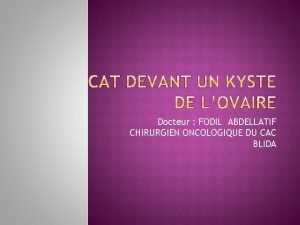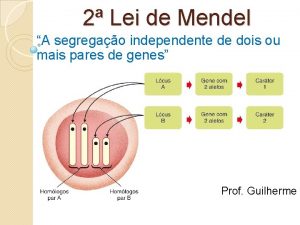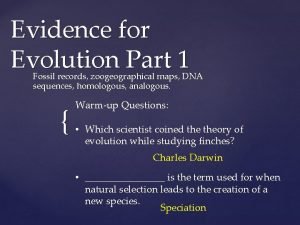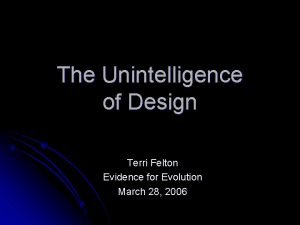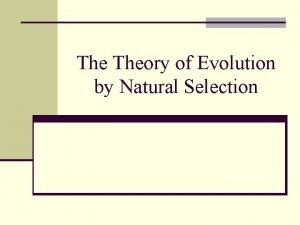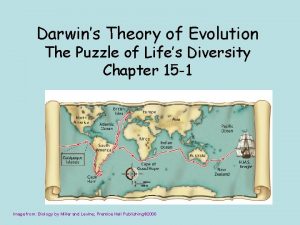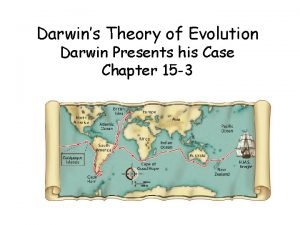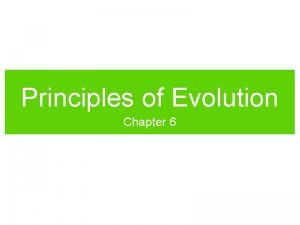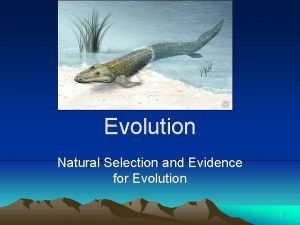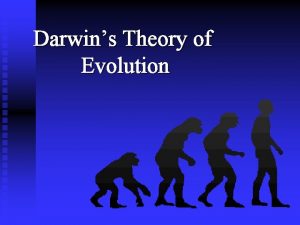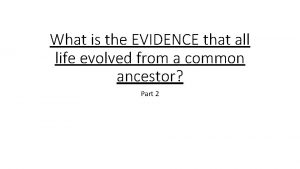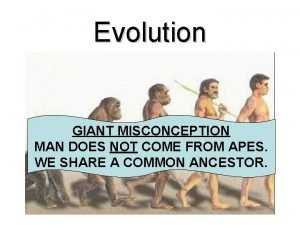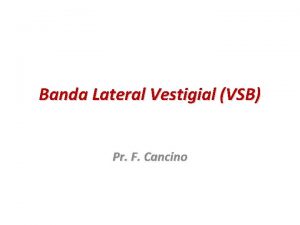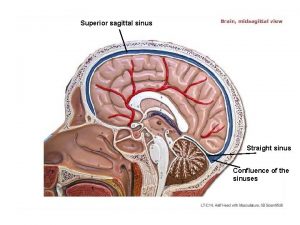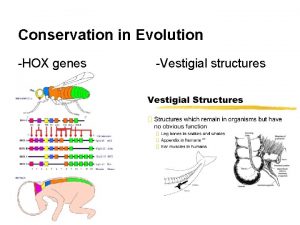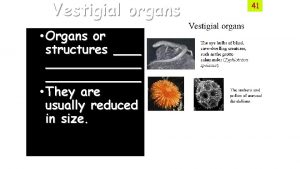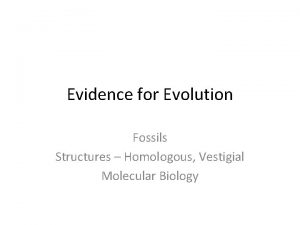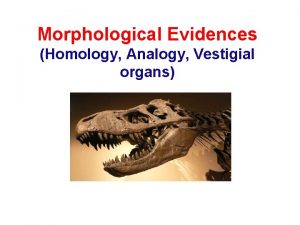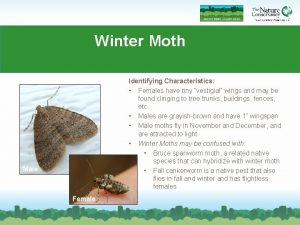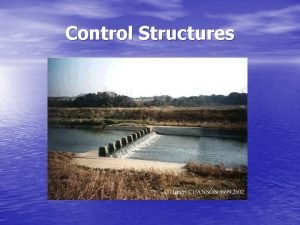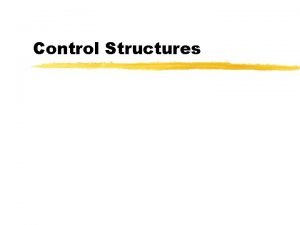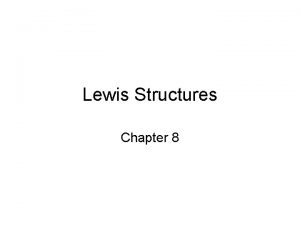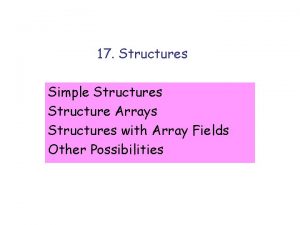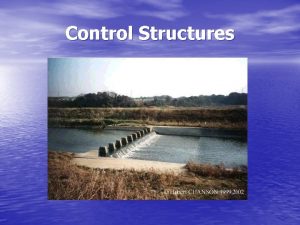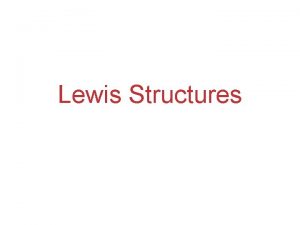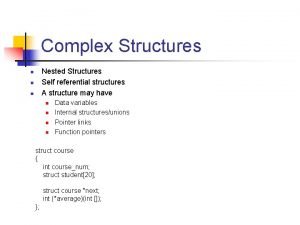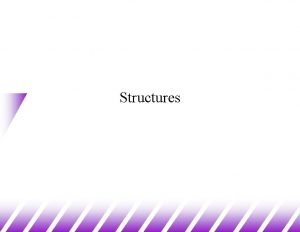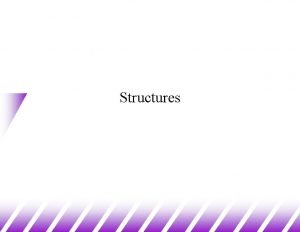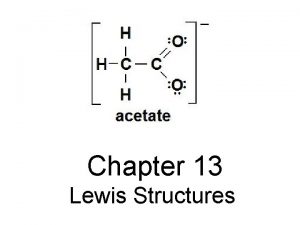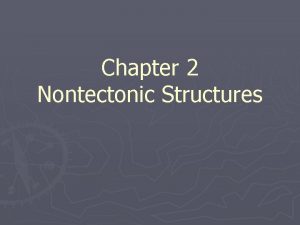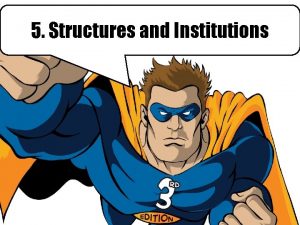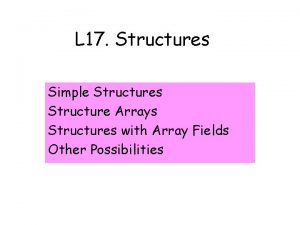Vestigial Structures Vestigial Structures are structures that are










































- Slides: 42

Vestigial Structures • Vestigial Structures are structures that are the reduced forms of functional structures in different species. Examples: 1. Snake Pelvis: The pelvis is the attachment point for legs and is therefore nonfunctional in an animal without legs

Vestigial Structures 2. Kiwi Wing: The wings of kiwis are too small to be of any use in flight 3. Human Appendix: Important for digestion in many mammals, but of limited use in humans & some apes

What are some evidence of Evolution? • Analogous structures can be superficially similar in construction, but are NOT inherited from a common ancestor. • Example: The wing of an eagle & the wing of a insect have the same function (both enable the organism to fly) – but are constructed in different ways & from different materials.

What are some evidence of Evolution? * While analogous structures do not indicate close evolutionary relationships, they do show that functionally similar features can evolve independently in similar environments.

Evidence #3: COMPARATIVE EMBRYOLOGY

What are some evidence of Evolution? Similarities in Early Development In their early stages of development, chickens, turtles, and rats look similar, providing evidence that they shared a common ancestry.


Evidence #4: COMPARATIVE BIOCHEMISTRY

What we know… • All cells rely on DNA to make proteins. • Using new technologies, biologists are able to determine the amino acid sequences in proteins to determine evolutionary relationships among various species of organisms. • The more closely related two species are, the greater the similarity in amino acid sequences of their proteins.

For example:

Evolution Video Click here for video clip: Darwin, the Beagle, and Finches: Darwin Discovers Evidence of Natural Selection

Types of Evolution There are 5 main types

Divergent Evolution: When two species move away from the traits that they share with a common ancestor as they adapt to their own environments Also called Adaptive Radiation… Produces homologous structures, And are more CLOSELY related!

Convergent Evolution: When two distinct species with differing ancestries evolve to display similar features. Sugar Glider: Australian marsupial Produces analogous structures, Flying Squirrel A GA squirrel And are NOT closely related!

**Coevolution** l. Coevolution l. Pollination

Geographic Distribution of Living Species - Species now living on different continents had each descended from different ancestors. - Because some animals on each continent were living under similar ecological conditions, they were exposed to similar pressures of natural selection. • They ended up evolving certain striking features in common… but are NOT related! • This is called Convergent Evolution

Punctuated Equilibrium Evolution that has long periods of stability or “unchange” followed by short periods of rapid change.

Gradualism A change that is very slow over time. It’s hard to notice a difference over a short period of time…it is slow and gradual.


5. Biological Resistance Some organisms obtain a mutation that makes them resistant to a toxin (antibiotic or pesticide). Overuse of antibiotics & pesticides create populations of “super bugs”. This is why you need to take your antibiotics for the entire time… You expose the bacteria to the toxin; but if you don’t kill them all (take all your medicine), then you “taught them” how to resist the antibiotic!

Resistance Explanation of how resistance happens: http: //www. sumanasinc. com/scienceinfocus/sif_antibiotics. html Explanation of how bacteria transmit resistance: http: //survivalrivals. org/the-x-bacteria/animation Video about antibiotic resistance: http: //www. youtube. com/watch? v=W-Wumll. RPLI

5. Other patterns of selection Frequency of Phenotype Generic Bell Curve for Natural Variation in a Remember the graph…? Complex Trait Phenotype (height)

5. Other patterns of selection a. Stabilizing Selection Key Low mortality, high fitness Percentage of Population High mortality, low fitness Selection against both extremes keep curve narrow and in same place. What good reasons can you come up with for this trend? Human babies that have a really low birth weight… Human babies that have a really high birth weight… Birth Weight

l. In stabilizing selection, the bulk portion of the bell-shaped curve is favored; l. The average phenotype is favored

b. Directional Selection Key Directional Selection Food becomes scarce. Low mortality, high fitness High mortality, low fitness

l. In directional selection, the one side of the bell-shaped curve is favored; l. The one extreme phenotype is favored over the other, over the average

c. Disruptive Selection Low mortality, high fitness High mortality, low fitness Population splits into two subgroups specializing in different seeds. Beak Size Number of Birds in Population Key Number of Birds in Population Largest and smallest seeds become more common. Beak Size

l. In disruptive selection, both end portions of the bell-shaped curve are favored; l. Both extreme phenotypes are favored over the average

Adaptation: body parts, body coverings, or behaviors that help an organism survive its environment or reproduce more effectively

Adaptations: • Mimicry: Adaptation in which one species evolves to resemble another species for protection or other advantages.

Adaptations: • Camouflage: Adaptation that allows organisms to blend into their surrounds.

Adaptations: • Imprinting: a form of learning in which a very young animal fixes its attention on the first object experience and then follows that object

Plants: Tropisms (Growth Responses): 1) Phototropism: Responds to light

Plants: Tropisms (Responses): 2) Thigmotropism: Responds to touch

Plants: Tropisms (Responses): 3) Gravitropism: Responds to gravity Click here for link to cool videos online.

Plants: Tropisms (Responses): 4) Hydrotropism: Responds to water

Cactus Ridges: Expand to store more water when it rains Flowers: Thorns: Waxy Covering: Can reproduce Sexually as well as asexually Prevent water loss Protect against being eaten No Leaves: Prevent water loss

Polar Bear Short/small Ears: Thick Blubber: Save Heat Keep warm Large Paws: Walking on snow White/clear Fur: Blend in with snow Long Claws: Catching prey/digging

Adaptation Prompt Draw an organism and describe the adaptations that make it “fit” (as in ‘fitness, ’ ‘survival of the fittest’). 1. ) Organism must be drawn, in color, & neat 2. ) Must include background environment 3. ) Must have at least 3 adaptations w/ explanation of advantage for survival/reproduction Not adaptations: How long they live, where they live, what they eat Adaptation examples: * Large paws, thick beak, bright colored feathers, skinny legs, large ears, sharp teeth, fur thickness…. Hint: Must be clearly related to survival or reproduction!!

Another example to demonstrate these selection patterns: http: //bcs. whfreeman. com/thelifewire/ content/chp 23/2302001. html

http: //devour. com/video/the-evolution-of-life -on-earth/

The End
 Insidan region jh
Insidan region jh Vestigial structures
Vestigial structures Analogous homologous and vestigial structures
Analogous homologous and vestigial structures Homology vs analogy
Homology vs analogy Vestigial structures example
Vestigial structures example Vestigial structures in giraffes
Vestigial structures in giraffes Vacuole
Vacuole Vestigial structures
Vestigial structures Vestigial structures
Vestigial structures Homologous structures
Homologous structures @• ꮇꮼꮛꮢꮦꮛ •:oveewatch en el youtube azul
@• ꮇꮼꮛꮢꮦꮛ •:oveewatch en el youtube azul Vestigial structures
Vestigial structures Defintion of a fossil
Defintion of a fossil Vestigial structures
Vestigial structures Vestigial structures
Vestigial structures Origin
Origin Tìm độ lớn thật của tam giác abc
Tìm độ lớn thật của tam giác abc Sau thất bại ở hồ điển triệt
Sau thất bại ở hồ điển triệt Thơ thất ngôn tứ tuyệt đường luật
Thơ thất ngôn tứ tuyệt đường luật Con hãy đưa tay khi thấy người vấp ngã
Con hãy đưa tay khi thấy người vấp ngã Thơ thất ngôn tứ tuyệt đường luật
Thơ thất ngôn tứ tuyệt đường luật Tôn thất thuyết là ai
Tôn thất thuyết là ai Phân độ lown ngoại tâm thu
Phân độ lown ngoại tâm thu Chiến lược kinh doanh quốc tế của walmart
Chiến lược kinh doanh quốc tế của walmart Gây tê cơ vuông thắt lưng
Gây tê cơ vuông thắt lưng Block nhĩ thất độ 2 type 1
Block nhĩ thất độ 2 type 1 Estructuras homólogas
Estructuras homólogas Kyste vestigial ovaire
Kyste vestigial ovaire Ufpa na drosophila melanogaster a cor do corpo
Ufpa na drosophila melanogaster a cor do corpo Vestigial
Vestigial Vestigial organs
Vestigial organs Snake vestigial legs
Snake vestigial legs Whales have vestigial legs. this suggests they _____.
Whales have vestigial legs. this suggests they _____. Whales have vestigial legs. this suggests they _____.
Whales have vestigial legs. this suggests they _____. Vestigial
Vestigial Example of vestigial structure
Example of vestigial structure Lamarck's theory of evolution
Lamarck's theory of evolution Why is the nictitating membrane vestigial
Why is the nictitating membrane vestigial Whale vestigial legs
Whale vestigial legs Pr f
Pr f Vestigial organs
Vestigial organs Homologous structures and analogous structures
Homologous structures and analogous structures Superficial palmar arch
Superficial palmar arch

